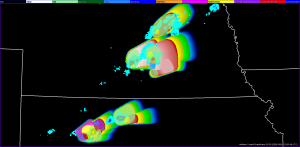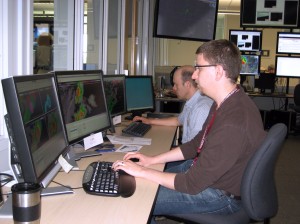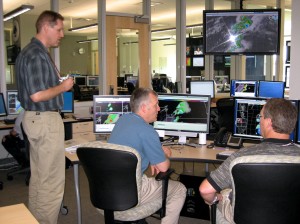Today the SPC has outlined a High Risk for severe weather in Nebraska/Iowa…with a moderate risk southward into Kansas. Thunderstorms are not anticipated in central Oklahoma, so the choice is obvious for a Prob-Warn IOP this afternoon.

Synopsis: A shortwave trough dug into the base of the standing long wave over the western states last night. This trough will eject over the Plains at a time coincident with peak heating, supporting widespread severe storms this afternoon and evening. A warm front lifted northward…taking up residence from northeast Nebraska through western Iowa and southward. A dryline will overtake the warm front from the west…providing impetus for an enhanced risk of severe weather around and north of Omaha, NE. The southern portion of the dryline will advance into southwest and north central Kansas. With dewpoints in the upper 60s to near 70, CAPE 2500-4000 J/kg, and 50 to 60 knot mid level flow accompanying the shortwave trough, severe storms are a near certainty. The particular mode and evolution is a greater question.
Per the NAM forecast seen below (courtesy College of Dupage), it is possible that two main areas of thunderstorms will develop, one north of the mid level jet and along the warm front, and another ahead of the dryline in northern KS and southern NE. There could be a minimum of activity along the nose of the jet near I-80 in NE.

One forecaster, Brad Colman, has other obligations, and must leave us today to head back to Seattle. The other forecasters are going to run through an archived Prob-Warn case early this afternoon. The archived case is a high priority so that we can have feedback from as many forecasters as possible after seeing the exact same data.
After a short break, we will then engage two teams with on Probabilistic Warnings, possibly in the areas shown above. One team will consist of myself and Eric, while the second team will consist of Kevin and Mark. With the potential for a long-lived and significant event, we will begin the IOP early, possibly 2030 or 2100 UTC, and run through 0200 UTC. A PDS tornado watch has already been issued for central Nebraska and northern Kansas, and storms are initiating along the dryline northeast of Goodland.
Patrick Burke (EWP Weekly Coordinator, 27-30 May)





